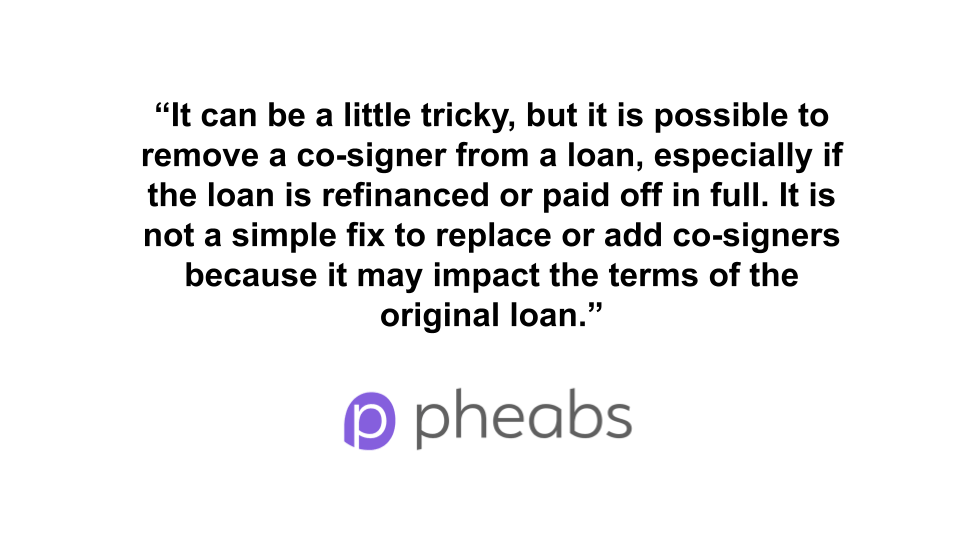Yes, typically paying off the loan in full is the easiest way to remove a cosigner from a loan. However, removing a cosigner in the middle of the loan agreement might be a little difficult.
Whether it is for an auto loan, personal loan or mortgage, it is not always a simple process to just take them off because the rates and terms of the loan are very dependent on the cosigner’s profile.
We understand that you might use a parent, friend, old boyfriend or work colleague as your cosigner, but if the loan agreement lasts 5 or 10 years and you are not on great terms, you may want to remove them or perhaps the individual may no longer want to be involved too. So you may want to get a cosigner removed and there are certainly steps you can take.
How Can I Remove a Co-Signer From a Loan?
The process of removing a co-signer or co-borrower from a loan depends on various factors, including the type of loan and the lender’s policies. Here are some common methods:
1. Refinancing the Loan
Refinancing is a common method to remove a co-signer or co-borrower. By applying for a new loan in your name only, you can use the new loan to pay off the existing one. This effectively eliminates the need for a co-signer or co-borrower, assuming your creditworthiness allows you to qualify for the refinance. But make sure that you can pay off that loan in full and do not get caught up in multiple loans or a spiral of debt.
2. Pay Off The Loan in Full
Paying off the loan entirely is another option to remove a co-signer or co-borrower. By settling the outstanding loan balance, the loan agreement essentially ends and you remove the joint responsibility and any need for a co-signer or co-borrower.
3. Negotiate with the Lender – Speak Openly
Some lenders may allow you to request the removal of a co-signer or co-borrower without the need for full refinancing or paying off the loan in full. This would require demonstrating your financial stability, income and strong credit history. Negotiating with the lender can lead to a loan solely in your name and some lenders are big and others are small and more willing to take things on a case-by-case basis. You have nothing to lose by speaking to your lender.
4. Get a Co-Signer Release Form
A handful of lenders can offer a co-signer release form and once filled in, the lender will review and the best outcome would be that it becomes a loan that just you are responsible for. You will need to show that you are able to keep up with repayments – through a good credit score and the financial resources to stay on top. This does not guarantee removal of the co-signer but it is a potential option. You should check the terms and conditions of your loan agreement to see if this is viable.
Background
It is common to have co-signers for loan products where the main individual customer has fair, bad or no credit – and it adds a layer of security and confidence for the lender if there is an extra person with a good credit record or someone who is older and more experienced to act as a co-signer.
This is popular for certainly loans for bad credit, known as co-signer loans, some mortgages (especially for young people) and around 18% of auto loans in the United States.
With a typical co-signer personal loan, you can borrow up to $50,000 through banks, private lenders and credit union. There is also something very similar called a personal loan with a co-borrower and this allows you to borrow up to $100,000 where both of you are contribute and make repayments and share the responsibility. It can also be known as a ‘joint loan.’
Why Might Removing a Co-Signer From a Loan Be Tricky?
But what is important is that the role of the co-signer is key to get that loan approved in the first place. The individual may not be successful in their own right, so they require an extra person to ‘guarantee repayment’ in case they default and cannot keep up. Hence, the loan is eventually approved not just taking the individual borrowers criteria into account, but it is pushed over the line because the co-signer has credibility and adds confidence to the overall loan being funded, the amount borrowed and the rates charged.
So, if the co-signer leaves or exits the agreement, this can disrupt the entire loan agreement and the rates and terms upon it was agreed – and some lenders might be reluctant to letting you make changes unless the loan is paid off in full.
Can I Replace The Current Co-Signer With Another One?
Not usually, it is not that simple to just replace one co-signer with another, because the terms of the loan are often based on the co-signers profile. To replace the individual with another could impact the terms of the loan, including the rates charged, the duration and loan amount. Some lenders may be more willing to take a view on individual cases and this is something that you could always ask, especially if the current co-signer has faced some unexpected circumstances.
Otherwise, the process to switch someone in and out is quite complex and can involve refinancing the loan under new terms, the existing co-signer releasing some paperwork or paying off the loan in full to end their involvement. Whilst not done often, you can always speak to your lender and explore some options.
Can I Add a New Co-Signer To An Existing Loan?
Whether it is an auto loan or a personal loan, it is not common to add new co-signers to existing loans, because it would require the individual to go through the approval process again, which could affect the rates and terms of the loan.
In some loans and cases, there is more than one co-signer involved and a specialist lender may be able to take a view on this – so it is always worth asking your lender for advice.
How Does it Affect The Co-Signer If The Lender Goes Out of Business?
If the lender goes out of business, you may not need to repay the loan at all. There may be a company that comes and liquidates it and tries to recover some money back, but if you have a loan outstanding or open and you are the co-signer, you could be let off if the company closes down and goes out of business.
Is The Co-Signer Removed From The Loan if Someone Dies?
If the main individual borrower sadly passes away, their estate would be responsible for repaying the loan. If there are no funds available to repay, the co-signer would therefore be required to step in and pay off the remaining debt.
Equally, if the co-signer passes away during the loan term, their spouse, partner or estate will continue to be responsible for the loan until it is paid off.
What Are The Differences Between a Co-Signer and Co-Borrower?
A co-signer is essentially a guarantor for the loan. Their primary responsibility is to step in and make loan payments if the primary borrower defaults. While co-signers play a crucial role in helping individuals qualify for loans, they typically do not have ownership rights to the purchased asset, such as a car or a home.
However, their credit and assets are at risk if the primary borrower fails to meet their obligations. Co-signers provide a layer of security for lenders by offering a secondary repayment source.
On the other hand, a co-borrower shares equal responsibility with the primary borrower. They are jointly liable for repaying the loan, and their assets can also be at risk if the loan defaults.
Co-borrowers typically have ownership rights and a shared stake in the purchased asset. Their contribution is not contingent on the primary borrower’s default; they are equally responsible for making loan payments from the outset. This shared responsibility can often make it easier for the primary borrower to qualify for a loan and may be particularly useful for large purchases like homes or vehicles.
These fundamental differences in roles and responsibilities should be carefully considered when entering into a loan agreement, as they can have significant implications for both the primary borrower and the co-signer or co-borrower.
| Criteria | Co-Signer | Co-Borrower |
| Responsibilities | Guarantor for the loan | Joint responsibility for the loan |
| Risk of Assets | No ownership rights to the asset; assets at risk if the borrower defaults | Joint ownership of the asset; assets at risk if the borrower defaults |
| Payment Contribution | Only when the primary borrower defaults | Equally responsible from the outset |
Why Would I Want to Remove a Co-Signer or Borrower from My Loan?
Several situations may prompt you to consider removing a co-signer or co-borrower from your loan:
Improved Creditworthiness: If you, as the primary borrower, have enhanced your credit score and financial stability, you may qualify for the loan on your own. This can free you from the need for a co-signer or co-borrower.
Financial Independence: As your financial situation becomes more secure, you might want to relieve the co-signer or co-borrower of their obligations. This can be particularly relevant for individuals aiming to establish financial independence.
Relationship Changes: In cases of co-borrowers, significant life changes, such as divorce or the dissolution of a business partnership, may necessitate removing a co-borrower from the loan to prevent further financial entanglement.
Securing Assets: If you want to secure sole ownership of the asset associated with the loan, such as a vehicle or a property, removing a co-signer or co-borrower is a necessary step.
Can My Credit Score Be Impacted As a Co-Signer?
You may wish to be removed from a cosigner loan agreement in order to protect your finances and credit score. But simply entering into an agreement will not negatively impact your credit score and accessibility for future products.
However, your credit score can be affected as a co-signer if the responsibility falls to you for repayment and you do not have the means to pay. Any missed repayments are put on your credit report and this will cause your credit score to fall, making it harder to access finance in the future and access lower rates.
Final Thoughts?
Consult with your lender to understand their policies and procedures regarding the removal of co-signers or co-borrowers. By taking these steps, you can gain greater independence and control over your financial obligations.





